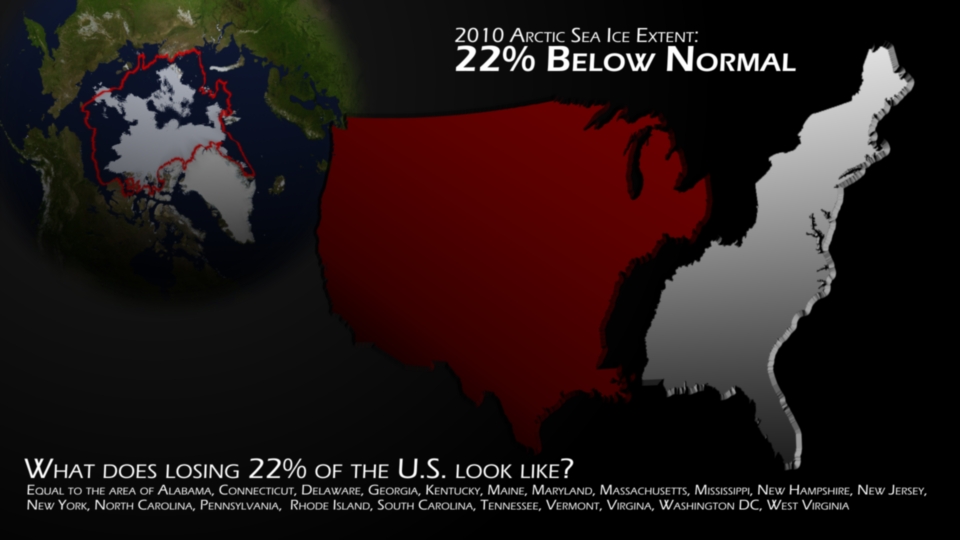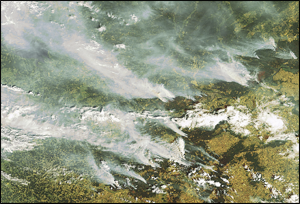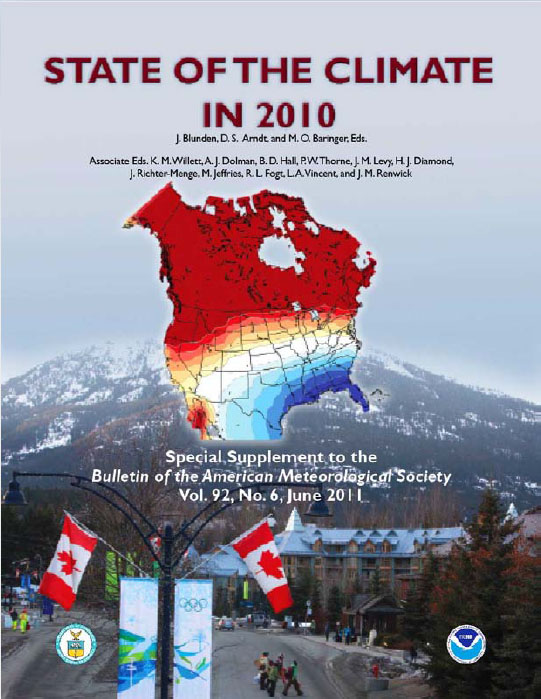Worldwide, 2010 was one of the two warmest years on record according to the 2010 State of the Climate report, which NOAA released on June 27, 2011. The peer-reviewed report, issued in coordination with the American Meteorological Society, was compiled by 368 scientists from 45 countries. It provides a detailed, yearly update on global climate indicators, notable climate events and other climate information from every continent.


This year’s report tracks 41 climate indicators — four more than last year — including temperature of the lower and upper atmosphere, precipitation, greenhouse gases, humidity, cloud cover, ocean temperature and salinity, sea ice, glaciers, and snow cover. Each indicator includes thousands of measurements from multiple independent datasets that allow scientists to identify overall trends.
While several well-known cyclical weather patterns had a significant influence on weather and climate events throughout the year, the comprehensive analysis of indicators shows a continuation of the long-term trends scientists have seen over the last 50 years, consistent with global climate change.
Thomas R. Karl, director of NOAA’s National Climatic Data Center in Asheville, N.C., said:
We’re continuing to closely track these indicators because it is quite clear that the climate of the past cannot be assumed to represent the climate of the future. These indicators are vital for understanding and making reliable projections of future climate.
Last year was marked by important climate oscillations like the El Niño-Southern Oscillation and the Arctic Oscillation, which affected regional climates and contributed to many of the world’s significant weather events in 2010.
Highlights of some of the climate indicators include:

- Temperature: Three major independent datasets show 2010 as one of the two warmest years since official record-keeping began in the late 19th century. Annual average temperatures in the Arctic continued to rise at about twice the rate of the lower latitudes.
- Sea Ice and Glaciers: Arctic sea ice shrank to the third smallest area on record, and the Greenland ice sheet melted at the highest rate since at least 1958. The Greenland ice sheet melt area was approximately eight percent more than the previous record set in 2007. Alpine glaciers shrank for the 20th consecutive year. Meanwhile, average sea ice extent in the Antarctic grew to an all-time record maximum in 2010.
- Sea Surface Temperature and Sea Level: Even with a moderate-to-strong La Niña in place during the latter half of the year, which is associated with cooler equatorial waters in the tropical Pacific, the 2010 average global sea surface temperature was third warmest on record and sea level continued to rise.
- Ocean Salinity: Oceans were saltier than average in areas of high evaporation and fresher than average in areas of high precipitation, suggesting that the water cycle is intensifying.
- Greenhouse Gases: Major greenhouse gas concentrations continued to rise. Carbon dioxide increased by 2.60 ppm, which is more than the average annual increase seen from 1980-2010.
Several major cyclical weather patterns played a key role in weather and climate in 2010:
-
- El Niño-Southern Oscillation: A strong warm El Niño climate pattern at the beginning of 2010 transitioned to a cool La Niña by July, contributing to some unusual weather patterns around the world and impacting global regions in different ways. Tropical cyclone activity was below normal in nearly all basins around the globe, especially in much of the Pacific Ocean. The Atlantic basin was the exception, with near-record high North Atlantic basin hurricane activity. Heavy rains led to a record wet spring (September – November) in Australia, ending a decade-long drought.
- Arctic Oscillation: In its negative phase for most of 2010, the Arctic Oscillation affected large parts of the Northern Hemisphere causing frigid arctic air to plunge southward and warm air to surge northward. Canada had its warmest year on record while Britain had its coldest winter at the beginning of the year and coldest December at the end of the year. The Arctic Oscillation reached its most negative value in February, the same month several cities along the U.S. East Coast had their snowiest months ever.
- Southern Annular Mode: An atmospheric pattern related to the strength and persistence of the storm track circling the Southern Hemisphere and the Antarctic led to an all-time maximum in 2010 of average sea ice volume in the Antarctic.
The State of the Climate report is peer-reviewed and published annually as a special supplement to the Bulletin of the American Meteorological Society.

Summary: The NOAA released its 2010 State of the Climate report on June 27, 2011, detailing an update on global climate indicators, notable climate events and other climate information from every continent. The report shows that 2010 was one of the two warmest years on record.











